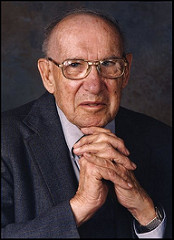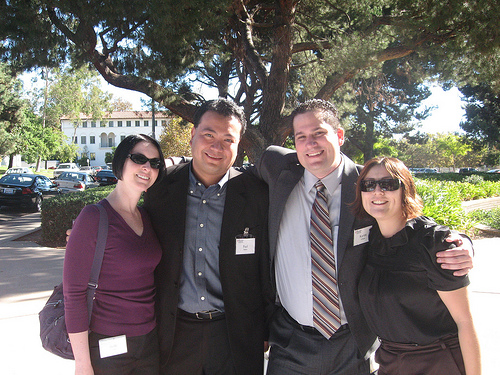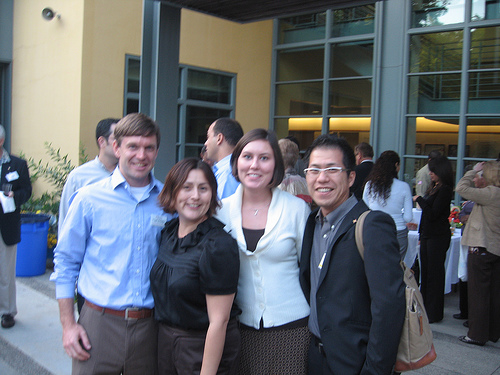Listen to the 7-minute podcast version
Watch a 1-minute introductory video
It sounds like a basic strategy question: “What business are you in?” Yet, when asked about their company, many leaders hesitate or offer conflicting answers.
Peter Drucker, described as “the founder of modern management,” was famous for helping companies focus on what was most important. These are his thoughts on that question:
Actually ‘what is our business’ is almost always a difficult question which can be answered only after hard thinking and studying. And the right answer is usually anything but obvious. (Peter Drucker)
 Drucker was also one of the first business consultants to assert that employees should be treated as assets, not liabilities. He originated the view of the company as a human community built on trust and respect for the worker and not just a profit-making machine. He recognized the importance of people.
Drucker was also one of the first business consultants to assert that employees should be treated as assets, not liabilities. He originated the view of the company as a human community built on trust and respect for the worker and not just a profit-making machine. He recognized the importance of people.
For your company, what is the answer to, “What business are you in?” No matter what industry you may be seeking to lead, a big part of the answer should be, “We’re in the people business.”
What Business Are You In?
How do you know if your company is in the people business?
One way is to closely examine the fundamental components of the organization and recognize the role people play in each of them:
- Strategy – developed and implemented by people;
- Leadership – the top people making decisions;
- Process – designed and executed by people;
- Human Resources – by definition, people!
And customers are handled by people, your company’s knowledge is created by people, and your people are largely responsible for driving business results.
Whether you realized it before or not, you’re in the people business!
Of all the decisions an executive makes, none is as important as the decisions about people, because they determine the performance capacity of the organization. (Peter Drucker)
Since you are in the people business, it pays to be intentional in how you manage that most critical of assets. Your people should feature highly in the strategy, leadership, and process components of the company as well as in human resources.
Management is about human beings. Its task is to make people capable of joint performance, to make their strengths effective and their weaknesses irrelevant. (Peter Drucker)
There is compelling business rationale to invest in your people, and development programs can produce a great ROI. But there is an even more important reason why you should care for their well-being: it’s simply the right thing to do.

Becoming Great at the People Business
How is your company doing? Below is a quick tool to help you determine where your company falls on the scale for becoming great at the people business:
Sound Strategy
- Meets Minimum – Awareness: The strategy includes focus on employee well-being.
- Average – Values: Written values, including wellness, are embraced by leaders.
- Good – Resources: Funding and headcount go toward people development programs.
- Great – Balance: It is understood that people have personal, emotional, and spiritual components and that a holistic lifestyle will maximize their morale and production.
Effective Leadership
- Meets Minimum – Communication: Leaders, individually and as a group, place an emphasis on communicating clearly, and they are trusted by employees.
- Average – Service: Leaders focus on their team as they seek to serve their employees.
- Good – Example: Leaders are taught there is often a cost of high achievement and are willing to do what it takes to manage their own personal issues effectively.
- Great – Authenticity: Executive show that being a great leader starts by being a good person and portray transparency and vulnerability to model the way for employees.
Process Excellence
- Meets Minimum – Skills: Subject matter expertise and quality are valued and taught.
- Average – Personal Excellence: Employees are encouraged to focus not only on improving quality metrics, but also on their own personal effectiveness.
- Good – Emotional Intelligence: The impact of negative personal issues and addictions are minimized with employee training on managing emotions and resilience.
- Great – Purpose: Employees are encouraged to develop a sense of purpose in their work which can include the spiritual significance of doing their job well.
Human Resource Programs
- Meets Minimum – Policy: Company policy sets clear expectations and accountability and also encourages a culture of wellness and recovery.
- Average – Lifestyle education: Employees can access wellness and resilience training.
- Good – Prevention programs: In addition to awareness and education, employees have access to a complete workplace wellness and addiction prevention program.
- Great – Reputation: The company is widely valued as a great place to work and a wellness and recovery friendly workplace.
All companies are in the people business, but there is a wide range in how they handle that responsibility. Great companies clearly understand the value of investing in their people.
Perhaps that’s what makes them great.
Question: How well does your company do at being in the people business?
Action: Think of a role you can play in creating the best work environment possible.


